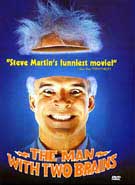Of two minds, or, neuroscience enters popular culture
 Neuroscience is rapidly permeating popular culture. Proof in point: Jim Holt’s recent New York Times Magazine article, Of Two Minds. But Holt sadly fails to meet the special responsibility of writers targeting the mainstream, not to promote oversimplified neuromemes that threaten to invade popular consciousness. He starts off apparently worrying about privacy:
Neuroscience is rapidly permeating popular culture. Proof in point: Jim Holt’s recent New York Times Magazine article, Of Two Minds. But Holt sadly fails to meet the special responsibility of writers targeting the mainstream, not to promote oversimplified neuromemes that threaten to invade popular consciousness. He starts off apparently worrying about privacy:
The human brain is mysterious—and, in a way, that is a good thing. The less that is known about how the brain works, the more secure the zone of privacy that surrounds the self. But that zone seems to be shrinking.
As proven by the neuropop “factoid” that scientists can now read your mind. Leapfrogging:
How will our image of ourselves change as the wrinkled lump of gray meat in our skull becomes increasingly transparent to such exploratory methods?
Second factoid: meditators can modify their brain structures . As if no-one had ever heard of neuroplasticity before. Wait, though:
…there could be revelations in store that will force us to revise our self-understanding in far more radical ways.
Sounds frightening. Third factoid: research showing that severing the corpus callosum (which is white, not gray) gives rise to weird stuff happening (he fails to tell us that this research was first done nearly a half-century ago). He goes on:
Pondering such split-brain cases, some scientists and philosophers have raised a disquieting possibility: perhaps each of us really consists of two minds running in harness.
Oh no! He proceeds to quote Thomas Nagel:
The ordinary, simple idea of a single person will come to seem quaint some day, when the complexities of the human control system become clearer and we become less certain that there is anything very important that we are one of.
Thomas Nagel (home page) is an eminent philosopher at NYU. But certainly Holt needed to put this quote in the context that Nagel is a leading anti-reductionist, famous for his insistence that consciousness cannot be reduced to brain activity. It seems unlikely that Nagel meant that scientific insights about the functioning of the hemispheres will give rise to a new understanding of what a “person” is.
Holt concludes:
The more that breakthroughs like the recent one in brain-scanning open up the mind to scientific scrutiny, the more we may be pressed to give up comforting metaphysical ideas like interiority, subjectivity and the soul. Let’s enjoy them while we can.
Brain scanners will eliminate the concept of subjectivity? (Hint: who is looking at the brain scans?) Interiority is a “metaphysical idea”? Neuroscience will eliminate the idea of the “soul”, which is “comforting”?
We can only hope that those responsible for interpreting and presenting the insights of neuropsychology to our culture at large will do much better than this in the future.
